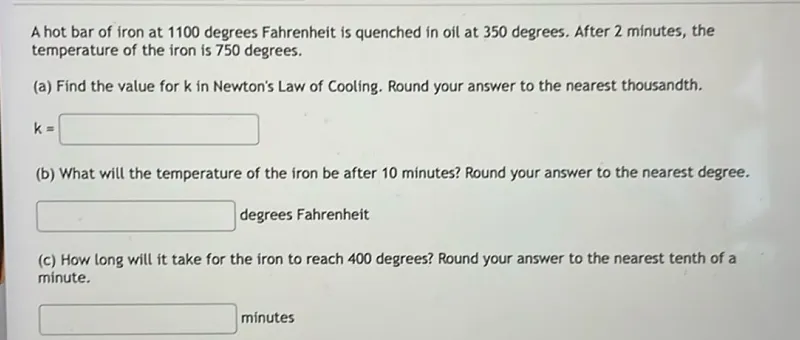I'll solve this physics problem about Newton's Law of Cooling step by step.
Find the value for $k$ in Newton's Law of Cooling.
Set up Newton's Law of Cooling equation
Newton's Law of Cooling states that the rate of change of temperature is proportional to the difference between the object's temperature and the surrounding temperature:
\(\frac{dT}{dt} = -k(T - T_s)\)
Where:
- $T$ is the temperature of the object
- $T_s$ is the temperature of the surroundings
- $k$ is the cooling constant we need to find
The solution to this differential equation is:
\(T(t) = T_s + (T_0 - T_s)e^{-kt}\)
Where $T_0$ is the initial temperature of the object.
Substitute the known values
Given:
- Initial temperature $T_0 = 1100°F$
- Surrounding temperature $T_s = 350°F$
- After $t = 2$ minutes, $T(2) = 750°F$
Substituting into the equation:
\(750 = 350 + (1100 - 350)e^{-k \cdot 2}\)
\(750 = 350 + 750e^{-2k}\)
\(400 = 750e^{-2k}\)
\(\frac{400}{750} = e^{-2k}\)
\(\frac{8}{15} = e^{-2k}\)
Solve for $k$
Taking the natural logarithm of both sides:
\(\ln(\frac{8}{15}) = -2k\)
\(-\ln(\frac{15}{8}) = -2k\)
\(k = \frac{\ln(\frac{15}{8})}{2}\)
\(k = \frac{\ln(15) - \ln(8)}{2}\)
\(k = \frac{2.708 - 2.079}{2}\)
\(k = \frac{0.629}{2}\)
\(k = 0.3145\)
Rounding to the nearest thousandth: \(k = 0.315\)
\(\boxed{k = 0.315}\)
Find the temperature of the iron after 10 minutes.
Apply Newton's Law of Cooling with the calculated $k$ value
Using the cooling equation with our calculated $k = 0.315$:
\(T(t) = T_s + (T_0 - T_s)e^{-kt}\)
Substituting the values:
\(T(10) = 350 + (1100 - 350)e^{-0.315 \cdot 10}\)
\(T(10) = 350 + 750e^{-3.15}\)
Calculate the final temperature
\(e^{-3.15} \approx 0.0429\)
\(T(10) = 350 + 750 \cdot 0.0429\)
\(T(10) = 350 + 32.175\)
\(T(10) = 382.175\)
Rounding to the nearest degree: \(T(10) = 382°F\)
\(\boxed{382 \text{ degrees Fahrenheit}}\)
Find how long it will take for the iron to reach 400 degrees.
Set up the equation with the target temperature
We need to find the time $t$ when $T(t) = 400°F$.
Using Newton's Law of Cooling:
\(T(t) = T_s + (T_0 - T_s)e^{-kt}\)
Substituting the values:
\(400 = 350 + (1100 - 350)e^{-0.315t}\)
\(400 = 350 + 750e^{-0.315t}\)
Solve for time $t$
\(400 - 350 = 750e^{-0.315t}\)
\(50 = 750e^{-0.315t}\)
\(\frac{50}{750} = e^{-0.315t}\)
\(\frac{1}{15} = e^{-0.315t}\)
Taking the natural logarithm of both sides:
\(\ln(\frac{1}{15}) = -0.315t\)
\(-\ln(15) = -0.315t\)
\(t = \frac{\ln(15)}{0.315}\)
\(t = \frac{2.708}{0.315}\)
\(t = 8.597\)
Rounding to the nearest tenth of a minute: \(t = 8.6\) minutes
\(\boxed{8.6 \text{ minutes}}\)
(a) \(\boxed{k = 0.315}\)
(b) \(\boxed{382 \text{ degrees Fahrenheit}}\)
(c) \(\boxed{8.6 \text{ minutes}}\)






